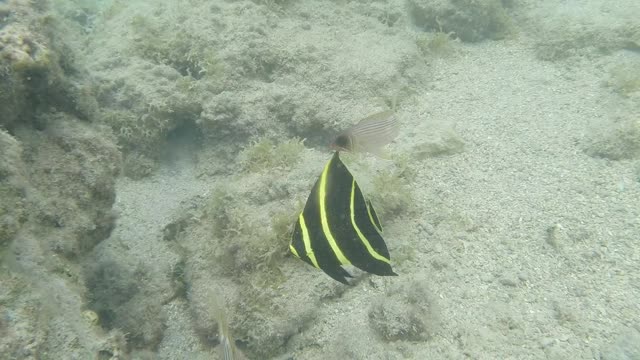Premium Only Content

Diving Under Water Along Side Koi Fishes
See this Diving Under Water Along Side Koi Fishes , In the deep ocean, the waters extend far below the epipelagic zone, and support very different types of pelagic fishes adapted to living in these deeper zones.
In deep water, marine snow is a continuous shower of mostly organic detritus falling from the upper layers of the water column. Its origin lies in activities within the productive photic zone. Marine snow includes dead or dying plankton, protists (diatoms), fecal matter, sand, soot and other inorganic dust. The "snowflakes" grow over time and may reach several centimetres in diameter, travelling for weeks before reaching the ocean floor.
However, most organic components of marine snow are consumed by microbes, zooplankton and other filter-feeding animals within the first 1,000 metres of their journey, that is, within the epipelagic zone. In this way marine snow may be considered the foundation of deep-sea mesopelagic and benthic ecosystems: As sunlight cannot reach them, deep-sea organisms rely heavily on marine snow as an energy source.
Some deep-sea pelagic groups, such as the lanternfish, ridgehead, marine hatchetfish, and lightfish families are sometimes termed pseudoceanic because, rather than having an even distribution in open water, they occur in significantly higher abundances around structural oases, notably seamounts and over continental slopes. The phenomenon is explained by the likewise abundance of prey species which are also attracted to the structures.
Hydrostatic pressure increases by 1 atmosphere for every 10m in depth.Deep-sea organisms have the same pressure within their bodies as is exerted on them from the outside, so they are not crushed by the extreme pressure. Their high internal pressure, however, results in the reduced fluidity of their membranes because molecules are squeezed together.
Fluidity in cell membranes increases efficiency of biological functions, most importantly the production of proteins, so organisms have adapted to this circumstance by increasing the proportion of unsaturated fatty acids in the lipids of the cell membranes. In addition to differences in internal pressure, these organisms have developed a different balance between their metabolic reactions from those organisms that live in the epipelagic zone.
David Wharton, author of Life at the Limits: Organisms in Extreme Environments, notes "Biochemical reactions are accompanied by changes in volume. If a reaction results in an increase in volume, it will be inhibited by pressure, whereas, if it is associated with a decrease in volume, it will be enhanced".This means that their metabolic processes must ultimately decrease the volume of the organism to some degree.
-
 LIVE
LIVE
I_Came_With_Fire_Podcast
13 hours agoRIOT SEASON IS BACK! | CCP Smuggler 2.0 | Texas Going Blue? | China Trade Talk
561 watching -
 1:00:41
1:00:41
Omar Elattar
5 hours ago“I Was Homeless On NYC Streets!” - Tequila CEO Shares Her Multi-Million Dollar Story
42.7K3 -
 DVR
DVR
The Pascal Show
2 hours ago $0.16 earnedRIOTS NATIONWIDE?! Anti-ICE Protests Throughout The Country! LA, NYC & More Absolute Chaos!
17.7K1 -
 27:54
27:54
Stephen Gardner
7 hours ago🔥RFK Jr. makes SHOCKING ANNOUNCEMENT!
54.8K30 -
 1:31:42
1:31:42
Badlands Media
1 day agoAltered State S3 Ep. 32: Project Cyberspace, Deep State Games & the War for Perception
62.5K1 -
 LIVE
LIVE
svgames
3 hours ago🟢LIVE - GAMING
72 watching -
 11:02
11:02
ARFCOM News
9 hours ago $0.66 earnedATF Goes After Pin & Weld Barrels | The FBI Caught Some Actual Nazis | Cop Shoots Tiny Puppy
15.8K8 -
 LIVE
LIVE
KingB33Gaming
9 hours agoThe Wind Waker | Nintendo Switch 2 Gamecube Virtual Console
71 watching -
 44:19
44:19
CarlCrusher
4 hours agoBombshell UFO News Immaculate Constellation REAL & Dr Hal Puthoff Appears on Joe Rogan
24.6K4 -
 LIVE
LIVE
Rhino6888
5 hours agoGTA STORY MODE, COME CHAT, DROP A FOLLOW!
72 watching